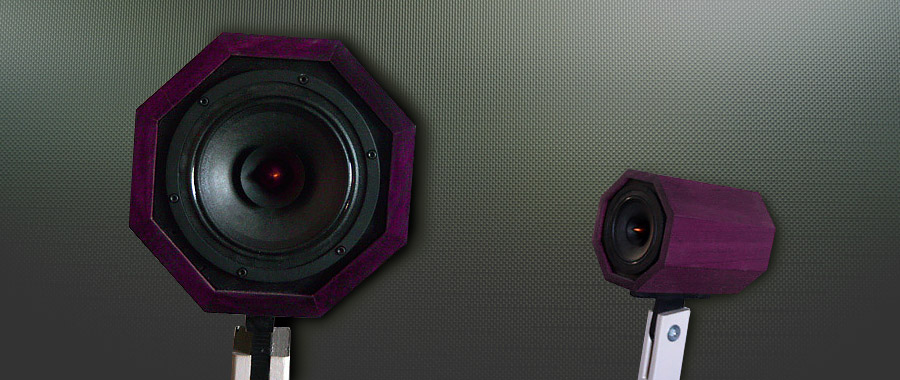
Grumpy’s Project
A two way system using a 10″ woofer and the Dayton PS-180-8 with a crossover point of 200 hz., electronic being preferred for reason of simplicity. A passive network may be designed in the near future to prove the point about passives mentioned in the Design Goals. This may also include a switching network to switch between passive network and one amplifier to a bi-amped system for A-B comparisons.
Design Goals
To design a two way system with a speaker that can handle the passband from 200 hz and up. While I have designed a few three way systems, the transition from the mid to the tweeter can be tricky. A golden eared listener can detect the crossover point, thus differentiating the upper register units. With a passive network, this can be difficult to avoid as components’ tolerances have to be very close, better than 0.5% and have to be matched to the load impedance imposed by each of the two units. This results in two slightly different crossovers. A high end midrange unit here has a nominal impedance of 7 ohms @ 317hz. At 4khz, the impedance is 16 ohms. Designing the upper limit of a bandpass filter for such a unit assuming 8 ohms is a waste of time. Many manufacturers publish impedance curves; use them.
Driver Selection
There are undoubtedly many 10 inch drivers that could have been used to compliment the Dayton. The one I used happened to be in my inventory, purchased a few years ago simply because they were on sale, had a 300w power handling capacity, and the T/S parameters permitted it’s use in a ported cabinet of 3 ft^3 with an F3 of 34 hz. Space for these cabinets was very limited; they are designed in two sections clamped together. The front half of the cabinet fits under the end tables while the slightly taller other half rises above the top of the aforementioned tables and now serves as a new location for the lamps. The 300w power handling capacity allows the woofer to keep up with the Daytons. The electronic crossover has output level adjustment controls.
The Daytons, once seen on Parts Express made me ecstatic (Dec. 2012). What a find. The last time I saw such a speaker was well over 50 years ago. It was the venerable GOODMANS AXIOM 80. I’ve seen some on auction websites bring as much as $4500.00 for a working pair.
Enclosure Design
The Daytons are housed in octagonal satellite cabinets with a minimal diameter to help reduce diffraction, however noticeable that may be, if at all; ergo, the front edges were not rounded. The wood is solid 0.75″ purple heart, almost as hard as ebony. The internal volume is 0.22 ft^3 as per Bass Box Pro, ver.6 and are sealed with a optimal Q of 0.707. The fill is 352g of pure New Zealand wool, washed but otherwise NOT treated. These units were ‘broken in’ at 3mm excursion for about an hour at 10hz while periodically monitoring the voice coil temp with an infrared thermometer. The free air resonant frequency was reduced from about 60hz to about 48hz. The T/S parameters of these two units were then derived using L.M.S. (Loudspeaker Management System by Linear-X) and differ slightly from those of the manufacturer, due to the breakin.
Amplifier Crossover Configuration
The amplifiers in the living room are all ADCOM. The Daytons are powered by a 60w/ch unit whilst the woofers are powered by 100w/ch. The preamp is fed through a Behringer model CX3400 electronic crossover, purchased here at P.E. simply because the price was right and at the time, I needed another toy, as if 3 other electronic crossovers wasn’t enough. There are two Furmans, one of which is in use in another system in the ‘music room, a converted and acoustically modified two car garage. The third is a vintage Pioneer model SF-850 that was salvaged from a junk heap at a speaker repair shop some 25 years ago. It didn’t work at the time but after acquisition of a service manual, a couple of transistors made short order if its affliction.
Conclusion
The end result was better than expected. They are bright by many standards but not as implied by the response curves. That is subjective as I like most of my music bright, especially old Kansas City Jazz of the roaring twenties and dirty thirties. That’s easily subdued with a graphic equaliser to suit personal preferences. Stereo imaging, despite that I’m not fanatical about that, is incredibly wide and stable. The speakers virtually disappear on well recorded stereo recordings. The Daytons are quite linear to about 18 khz, ergo a tweeter is superfluous.
Total cost of the satellites was less than $200. The stands were previously made to hold two other satellites housing a pair of Hi-Vi Trinity 6s. The rest of the equipment was previously purchased for a myriad of other reasons; I do a lot of experimenting but for the record, add about $100 for the 10 inchers and $50 for their cabinets; another $130 for the Behringer CX3400 electronic crossover. The purple heart was purchased on sale for about $60; normally $130. Total cost less then $500.
The piccies. The sequence, 1, 2, 3, 4, 5, 6, 7, 8 corresponds to (file numbers) 1251, 1245, 1246, 1247, 1248, DAYTON2, Zimp and LRmResp, respectively. This was added due to the 150 character limit for piccy description. It was my intent to clarify their content so the reader/viewer wouldn’t be left wondering “Who’s on first”.
1 (1251) The living room, such as it is or was. A dream to an audio buff but a nightmare to others. The Dayton satellites are in the foreground and the associated woofers are under and behind the end tables. In the corners are a pair of Briggs’ three ways similar to the original which can’t be seen in this piccy; it’s way to the right. On the wall is a pair of line arrays, an experiment using the HiWave BMR12 (299-208) but very silimar to the 297-212 and the 295-236 units still sold here on Parts Express. A project will soon be submitted. This piccy was taken with a wide angle lens as the farthest I could get was 14 feet away with the camera atop a tape recorder rack. The opposite wall is 16 feet wide.
2 (1245) The right channel. The two amplifiers are below the lower tape recorder; the electronic crossover is on the top of the shelf unit. In the lower left is a G. A. Briggs three way built by a half brother in 1957 which I was given in 1972. The corner system is the same with the exception of a corner design. The 3 ft^3 woofer cabinet that accompanies the Dayton is under and behind the end table.
3 (1246) Left channel. The tan stands were originally designed to hold cabs for the Hi-Vi Trinity 6. At the time, the intent was to allow them to blend in with the other antique finished furniture and cabinets. The pedestals house the 3 way passive network for those Trinitys but are now bypassed. Eventually, stands for the purple Dayton cabinets will be made.
4 (1247) Side view closeup. The purple colour is the natural colour of purple heart wood. It was polished with fine sandpapers and waxed. The surface feels like soft leather to the touch.
5 (1248) Frontal closeup
6 (DAYTON2) Frequency response @ 1w/7.5 ohms (ref. 1khz). This is measured at 1m on axis with the speaker in its enclosure and stuffed with 352g wool. The black curve is the actual response using a continuous logarithmic sweep and the red curve is 1/3rd octave smoothed. Response curves were swept at 2m and 4m with similar results with exception of approximately 6 dB and 12 dB drops due to distance, respectively. While that is correct in a non-reverberant field (free space or anechoic chamber) it is subject to a small reflection from the ground, ergo the insertion of the word, ‘approximately’.
7 (Zimp) Impedance curves of both units in wool stuffed cabinets.
8 (LRmResp) Response in my living room. The black trace is an actual response, without equalization, of the room using LMS. The peaks are normal in a reverberant field, due to reflections from any hard surface. The red trace is the black one smoothed to 1/3rd octave. It shows a response linear within 10 dB which is acceptable and better than most. The peak at 35hz is a perk; the one at 80hz is due to the room dimensions, about 15 by 17 with an 8 feet high ceiling. The dips at 60 and 120 are also due to dimensions. Also, the room is almost square, an acoustical no-no. The 8 ft. ceiling is also close to half the other two dimensions. Even numbered dimension ratios are not good. The high end response is flatter than that which is indicative of the actual driver response. (see #6 DAYTON2) This is attributed to wall to wall carpets, plush velour sofa, large armchair and heavy drapes on the window wall.
The LMS system uses two first order filters, each with a Q of 1 which can be cascaded to make a second order filter. It is claimed by the manufacturer that the noise floor can be reduced by 30 to 40 dB. This was verified many times, the most recent being Dec. 10, 2013. The noise floor (baseline) was found to be -35 dB, +/- 5 dB. Subtracting the noise floor curve from the frequency response curve produced the curves shown. Little to no difference was noticed between the curves above 150 hz., below which an increasing difference of several dB was noticed. This is attributed to ambient low frequency noise of vehicles on a main street about 1/4 mile away. That theory was verified by running another baseline sweep around 1 in the morning.
About the Designer
I’m retired and 70 years of age. In 1957, an uncle built a Wharfedale three way Briggs’ system. Until then, I heard my rock ‘n roll on a portable record player. After hearing that stuff on the three way, I was hooked on audio. That complete system now resides in my living room, refinished in mahogany. It comprises an EICO HF-60 preamp and HF-30 power amp, both mono and vacuum tubes. The turntable is an N33-H Rek-O-Kut Rondine which now has a new drive belt and motor bearings. The three way is a G.A.Briggs’ design comprising a W15FS in bass reflex enxclosure, internally braced and having an internal volume of 10 cubic feet. The midrange is a Super 10 FSB and the tweeter is the venerable Super 3. All are Wharfedale as Mr. Briggs founded the company in the dirty thirties. The original midrange was supposed to be the Super 8 FS/AL but wasn’t available at the time of purchase, so I was told. The crossover is also Wharfedale, a passive three way half section Butterworth filter, HS/CR3/2. It can be switched to a two way if a tweeter is not available, ergo the Super 8 FS/AL, which has an aluminum voice coil to reduce the moving mass thus giving better high frequency response. Since moving to Arizona, I’ve designed and built several systems mostly for musicians and several more for home use. One was a double tuned 8 ft^3 enclosure housing a Tannoy Gold triaxial for an elderly gentleman who had grandkids, ergo the dual tuning. By switching vents, his teenage grandkids could get the boom they wanted without having to increase the power by boosting the bass. There was also a 40 hz high pass second order filter which was also switched in when the vent was changed. It’s purpose was to filter the extreme lows and alter the Q of the system to produce a bit of a hump in the response around 60-80 hz.
Another was a single speaker to be used to reproduce a cello and it had to do a good job. The person who commissioned me had heard many systems and wasn’t too satisfied with them. That system ended up costing me more than it took to design and build but a couple of weeks after delivery, the fella called me and told me it was nothing less than perfect. A cello can be very hard to reproduce without unwanted resonances and/or a boomy sound. If the bass is cut, it sounds thin; if boosted, it sounds boomy. Despite the financial loss of the project, a much more illustrious reward came when he called me two weeks later. It was then that I found out he was a cellist for the Phoenix Symphony Orchestra.
There were many other such designs. One, developed over a couple of years with a friend, was later brought to a high end audio shop and compared against a $13000 pair of speakers. Initially, my friend and I were intimidated by the offer but much to our surprise, ours was preferred. That system is still in use in the living room.
I’m not an engineer by any means. I learned by reading books and experimenting and have been doing that for decades. Back in ’72, a friend for whom I had a lot of respect heard my first folded corner horns was so impressed he got goosebumps listening to Beethoven’s Fifth Symphony and John wasn’t one to show emotion.
I’ve had a lot of coaching along the way, the most illustrious was from one Paul Wilbur Klipsch. During one of his franchise visits and after the crowd had dissipated, he saw me sitting there alone with a three ring binder in hand and called me over. It was then that I asked him about something he stated in one of his earlier papers published in 1941 about the fluctuation of throat reactance as it baffled me (no pun intended). All my calculations seems to contradict that that which he wrote in the paper. He smiled, reached for his pen and my note book and wrote beside that which was printed. “I disagree with the author” and signed it PWK 750508. To me, that note holds a reverence similar to that of the Declaration of Independance or the Magna Carta.
In 1973, I studied Calculus and used it until moving west in ’75. A few years after my marriage went kaput, I got into computers. It was easier to write in BASIC despite it’s limitations as it didn’t handle anything above algebra. So, integrals had to be written algebraically as I couldn’t afford FORTRAN. The processor was a 2 mHz Zilog Z-80 with a math co-processor and the machine had 64k of memory and two 5 inch floppies. Once BASIC was loaded, there was 48k of memory left. It was slow to do the iterations until I got a BASIC compiler, after which it had to stop to allow the printer to empty its buffers. The data printed and scrolled on the screen faster than one could see it much less read it.
In the last 5 or so years, I got into the restoration of reel to reel tape recorders, especially the venerable Revox A77; built to last but with limited electronics. There are several here, two of which are high speed, 15 ips and half track and all meet or exceed the factory specs. of the 60’s. I also dabble with active filters, the most ambitious of which was a very high Q notch filter. The corner frequencies were 5 hz apart and in the center, 64 hz, it dropped by -40 dB. The resistor values had to be exact, +/- nothing. They were made with a few to several resistors in a series-parallel configuration. The capacitor values were all normalised to 0.1 uF with zero tolerance, all selectively chosen after measurement with a good capacitance meter.
Shortly after arriving in Arizona, I got gold fever – bad and spent a lot of time in the Superstitions looking for the Dutchman’s Lost Mine. These excursions were made in the summer when no one with any sense would go there in 110+ degree temperatures. Never found a nugget or a vein but we did meet one very colorful old gentlemen once. This fella had the appearance and decorum of one who just stepped out of the late nineteenth century. The mine, if it ever existed, remains lost.
Over the years, I’ve developed the philosophy that while getting older is inevitable, growing up is optional. That DEQ2496 digital equalizer gets used also to tailor the system to sound like a 1950’s jukebox at the push of a button. It’s a nostalgia thing. Admittedly, the two thousand or so doowop tunes I have on tape sound nice on modern day equipment but every now and then I just have to jump into my DeLorean, turn on the flux capacitor, set my time circuits to the fifties and get that baby up to 88 miles an hour. I’m not one who’s lost in the fifties. I was a teenager then and Mama was right when she said “these are the best years of your life.”

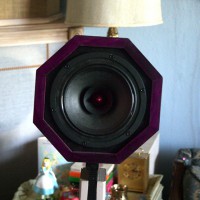
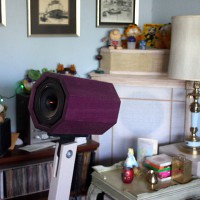
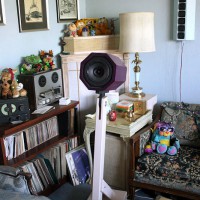


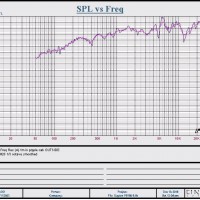
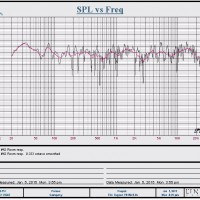
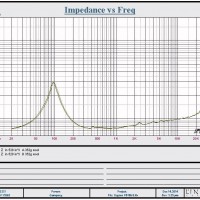
going through my late father-in-laws stuff and came across a wharfedale half section separator unit. looks like something out of a 50’s sci-fi movie.
i assume there is another one around somewhere. can you tell me anything about this piece?
jd
Hello John.
Please accept my most profound apologies for the delay as I had no notification of replies to this post. I think I have now rectified that problem.
I feel it safe to assume that the crossover is in a brown wood box and has 6 terminals on top, with two variable controls and a toggle switch indicating 2 way or 3 way.
It’s an old crossover dating to the late 50’s; I have 4 of them. It’s a second order (6 dB/octave) 3 way filter, 800 hz & 5000 hz) and other than the two level controls becoming flaky, is quite a good unit. It also came in a less popular 400hz/5000hz unit) The model is HS/CR 3/2. The controls can be cleaned; the components are encased in wax. The top can be lifted by removing the 6 screws. There was also a 2 way unit of similar appearance with a crossover point at 1000 hz.
As for the designation “half section”, your best bet is to google the term “half section filter”. Frojm what I understand about filters, half section would be 1 pole, 6 dB/octave. From that i’d assume a full section to have two poles, 12dB/octave. The latter would have a series coil in the woofer circuit and a parallel capacitor. It can get extremely complicated.
Robert
I am curious of the speaker made for the cello player. Can you give more details?
As a former orchestra bass player I often test speakers by playing recorded double bass through them.
Mark, thank you for your interest in that speaker.
If memory serves me well, it comprised a 12″ woofer and a 15″ passive radiator. The cabinet volume was about 4.5 ft^3. It was initially tuned (by ear) by the traditional method of adding mass to the PR. However, a limit was soon reached as that mass increased the momentum of the PR, which would cause it to overshoot in either direction. The suspension of the PR was stiffened in increments using a thick latex paint until the damping became audibly noticed. This was done by charging a 3000 uF capacitor to about 30 volts and discharging it into the woofer voice coil, which would drive the cone a few millimeters for a fraction of a second. This equates to about 112 W for 24 mS. The idea was to get a highly damped sound, i.e. a sharp boom rather than an elongated booooom. Some mass also had to be removed from the PR. The process took hours and I have to admit the “sound” evaluation was very subjective. My reference was the plucked bass viola or cello at the end of the 4th movement of Jean Sibelius’ Symphony #2 in D which I heard in a concert hall about a year earlier.
Had I been in possession of a pulse generator, the capacitor wouldn’t have been necessary. It was the closest thing I could concoct to simulate the generator. A 3000uF capacitor will discharge into an 8 ohm load in about 24mS. A full wavelength at this duration would be about 42 hz.
Admittedly, a sealed cabinet could have yielded a better damping but at the cost of low frequency roll-off. The only other option was a horn loaded bass but the size of such a system was prohibitive.
Robert
A very attractive & interesting system design. However, you Sir have piqued my interest so much, I would thoroughly enjoy having the pleasure to meet & visit with you. Although your knowledge far exceeds mine exponentially, much like you, I learned what & how by reading about, studying, calculating, experimenting (trial & error), then constructing what I wanted. I’m 57 & I began my journey in high school working in a small town’s TV shop, repairing everything from magnetic clutches or other electromechanical parts off of farm machinery, to rebuilding some people’s ”can’t part with favorite” electric razors to repairing the X-Ray machine in the town’s hospital. Oh, I repaired TVs as well as building my 1st color TV (not a”Heathkit”). I also designed & built my 1st C-Band satellite system. Building my own self designed sound systems is 1 of my main passions however, I have so many other interests or passions that I never seem to have the time to do much more than just drawing up a design for a system. I have pages & pages of so many scaled down designs of everything from buildings to vehicle designs, linear actuator powered lifting devices to, of course, speaker systems as well as countless other projects that would take too long to describe or define . Meeting like minded people as you & talking shop, so to speak, is one of my favorite pastimes. You take care, Sir.
To R.C. Your comment is very much appreciated. That you would notice my project among the hundreds present is flattering. Making your personal acquaintance would be interesting to say the least. Unfortunately, this medium doesn’t provide a way privately communicate as do all of the four audio fora (forums) to which I subscribe. About four years ago I met a fella in N.Y. through such a forum and we still communicate. I do have a website that’s been online for about 25 years. I don’t know if P/E allows links here but I’ll take the chance but I did see on a reply form a place to enter a website. Based on that, here’s the link to the loudspeaker pages there. https://www.ln271828.net/p3.htm
After reading about your experiences, I conclude that your electronics expertise far exceeds mine as I couldn’t repair a television receiver, much less build one. I have assembled many Heathkits, some of which are still in use. While all have been replaced with Tektronix equipment, the Heathkits are still on the bench and used periodically for nostalgic reasons. I have, though, modified a few of the seven venerable Revox A77 recorders I’ve restored, including heads replacements with new heads. During recording, no one has yet been able to differentiate between the source and the tape when switching between them unless they are astute enough to catch the 0.2 second skip or duplication when switching from tape to source or from source to tape, respectively at 7.5 ips. A few of those machines are biased for vintage tape to maximize their performance. One machine, a half track high speed (7.5/15 ips) actually exceeds factory spec. on Maxell tape dating to the late 80’s.
As for speakers, I’ve been seriously involved in them for the last 35 years. My so called ‘pieces des resistances’ is a pair of Klipsch type horns. I refrain from calling them Klipschorns as they are not such; these fellas dwarf a Klipschorn; they unload at 34hz.whereas the Klipschorn unloads at 47hz. The Klipschorn has a horn length of about 4 feet but my behemoths have a horn length of 7 feet. Believe it or not, I actually had some advice on these from none other than Paul Wilbur Klipsch. I’ve refused a few offers to build some despite the attractive monetary offerings for no other reason than respect for Mr. Klipsch. It took three pairs to get these right, the third pair being completed in the late seventies. The other two pairs were destroyed after completion of the subsequent pair. The first pair was a two way and built in an apartment, using a keyhole saw, a 6 inch block plane and a hand operated drill.
Designing a loudspeaker system using all the best engineering practices doesn’t necessarily produce the better sounding system as how something sounds is purely subjective. Consider the definition of sound. the sensation produced by stimulation of the organs of hearing by vibrations transmitted through the air or other medium. – Webster’s Unabridged Dictionary, which brings to mind the question, If a tree falls in a forest and no one is there to hear it, does it make a sound? Based on the above definition of sound, the answer has to be NO. The same logic can be applied to colour. The eye responds to wavelengths between 400nM and 700nM and the brain interprets that as colour from red to violet. But until that electromagnetic wave strikes the optic nerve, it is nothing more than an electromagnetic wave, therefore colour doesn’t exist without the eye as sound doesn’t exist without an ear.
I’d best stop here as a continuance of this dialogue can become very philosophical. Again, thank you for your comment.
Robert